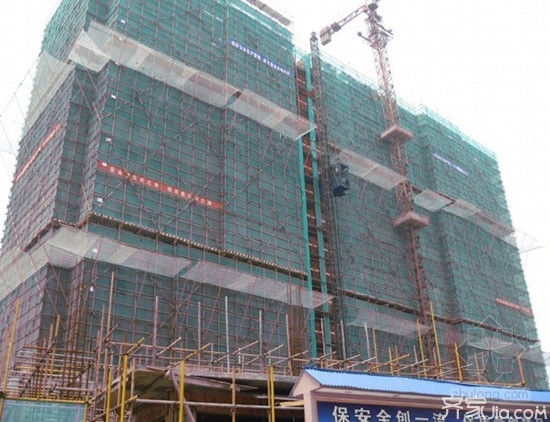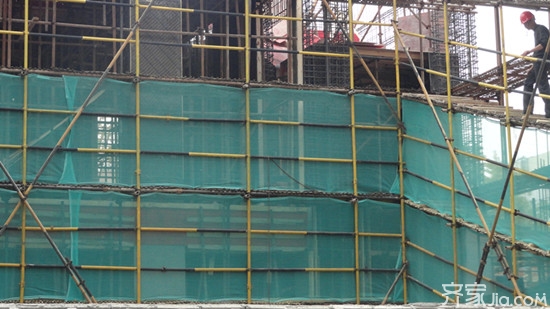
Privacy statement: Your privacy is very important to Us. Our company promises not to disclose your personal information to any external company with out your explicit permission.
The construction industry has always been a very important industry and a major pillar of the national economy. Therefore, all countries attach great importance to the development of the construction industry. In this context, the application of scaffolding is naturally very extensive. Do you know the specifications for double-row scaffolding ? Today we will take a look at the double-row scaffolding plan.

First, build a plan
1, materials and specifications
According to the requirements of JGJ59-99 standard, the steel pipe shall be erected. The size of the steel pipe shall be φ48×3.5mm and steel fasteners shall be used.
2, build size
2.1 The total height of the building is to be erected, and it is required to be erected along with the construction progress, which is 1.5 meters higher than the construction layer.
2.2 erection requirements, according to the actual situation at the scene, the use of double-row scaffolding, construction body inside the pole using a safe dense mesh fully enclosed enclosure construction. The first tier of flat net is set up at 3.2 meters high, with the progress of the construction set up with the layer of network, set up every 6 meters of interlayer network.
2.3 Construction requirements
a. The distance between the poles is 1.5 meters, and the pole base mat is long (20CM x 5CM x 4CM long pine board), and the steel base (1CM x 15CM x 8MM steel plate) is used. Steel cores are installed in the middle of the base and the height is greater than 15cm. The height of ground 20CM set vertical and horizontal sweeping pole. Continuously set on the inside of the vertical pole, the vertical pole adopts docking, and the joints are arranged staggered. The height direction is staggered by more than 50cm, and the adjacent joints should not be in the same span. The junction between the large crossbar and the upright shall not be greater than 50cm. The top pole can be overlapped, the length should not be less than 1M, two fasteners. Pole vertical deviation, when the height is less than 30 M, the requirement is less than 1/200 of the height.
b. Large bar
The distance between the big bars is controlled at 1.5M so that the vertical grid can be set up. The large bar is set inside the vertical bar. The extension of each side should not be less than 10CM, but should not be greater than 20CM. The length of the rod must be butt-jointed, and the distance from the main contact should not exceed 50 cm.
c, small crossbar
The small cross bar is placed above the large cross bar, and the length of the large cross bar is not less than 10 cm. The distance between the small cross bar: The small cross bar must be provided at the intersection of the vertical bar and the large cross bar. The foot plate is 75 cm, and it does not protrude into the wall. Less than 18CM.
d. Scissors
There should be a set of scissors at each corner of the outer scaffolding, and every 6-7 (9-15M) poles in the middle. The scissor support is continuously installed along the scaffolding height from the foundation, the width is not less than 6 meters, the minimum span is 4 spans, and the maximum span is 6 spans. The angle to the ground is: 45 degrees across 6 spans, 50 degrees across 5 spans, and spans 4 crosses 60 degrees. Scissor struts need to be overlapped, and the overlap length is not less than 1M. The use of three fasteners is evenly distributed, and the tip distance from the fastener is not less than 10cm.
e, scaffolding
Should be full of scaffolding, no probe plate, no uneven, and to set the feet, the height of the footrest 18CM. Full paving is less than 10cm from the wall.
2.4 frame and building pull knot
Scaffolding height is above 7M and each height is 4M. The level is firmly tied with the building every 6M, and fixed with 50CM steel pipe inside and outside. And add the top support so that it can bear tension and pressure at the same time to ensure that the connection between the frame and the building is firm, without shaking or falling.
2.5 Drainage measures: There must be no accumulation of water at the bottom of the frame and a drainage ditch.

Second, scaffold acceptance
1. The external scaffolding must be erected by the holder of the certificate, and the inspection shall be carried out layer by layer as part of the increase of the floor, and the acceptance shall be once for the height of 9M. If it does not meet the requirements, it shall be promptly rectified.
2. Acceptance of external scaffolds shall be checked according to the items listed in the "External Scaffolding Inspection Scale" in JGJ59-99 and the requirements of the construction plan, fill in the acceptance record sheet, and set up personnel, safety personnel, construction workers, project managers. Visa can be delivered for use.
3, must have quantitative acceptance content.
III. Labor Arrangement for External Scaffolding
1, according to the scale of the project and the number of scaffolding to determine the number of erection personnel, a clear division of labor and technical disclosure.
2. It is necessary to establish a management organization composed of project managers, construction workers, safety personnel, and technical personnel. The responsible person shall be responsible to the project manager and bear direct responsibility for commanding, dispatching and inspection.
3. The erection and removal of external scaffolds must be equipped with adequate auxiliary personnel and necessary tools.

IV. Technical Measures for the Installation of External Scaffolds
1. Drainage ditch should be dug outside the base of the external scaffold pole to prevent rainwater from soaking the foundation.
2. The external scaffolding shall not be erected within the safe distance from the overhead lines and shall be reliably grounded for lightning protection.
3. The external scaffold must be repaired and reinforced in time to achieve sturdiness and stability and ensure construction safety.
4. It is strictly forbidden to use steel, bamboo and steel wood for the external scaffolding. It is forbidden to use fasteners, ropes, iron wire, and bamboo shoots.
5. Personnel erected on scaffolds must hold certificates and use helmets, safety nets, and non-slip shoes correctly.
6. Strictly control the construction load. The stacking of materials on the scaffold board must not be concentrated. The construction load must not exceed 2 KN/M2.
7. Control tightening torque of fastener bolts. Torque wrenches are used to control torque torque in the range of 40-50N.M.
8. It is forbidden to have a probe plate on the scaffolding board. When laying scaffolding boards and multi-layer work, balance should be transmitted within and outside the construction load as much as possible.
9, to ensure the integrity of the scaffolding, shall not be tied together with the derrick, tower crane, not cut off the body.
V. Safety Technical Measures for Dismantling of External Scaffolds
Before demolishing the frame, it is necessary to fully inspect the feet to be removed.
The above description of the double-row scaffolding setup and the double-row scaffolding construction plan are briefly introduced here. We hope to help you. For more information, please visit this website. Stay tuned.
Construction installation decoration construction knowledge construction color matching scheme construction contract
December 13, 2022
이 업체에게 이메일로 보내기
December 13, 2022
December 12, 2022

Privacy statement: Your privacy is very important to Us. Our company promises not to disclose your personal information to any external company with out your explicit permission.

Fill in more information so that we can get in touch with you faster
Privacy statement: Your privacy is very important to Us. Our company promises not to disclose your personal information to any external company with out your explicit permission.